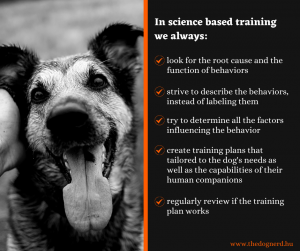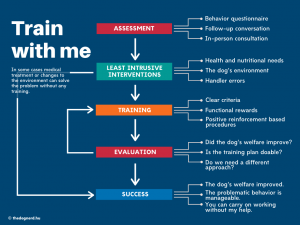Calling your training “science based” is all the rage right now – I also advertise my services with that label. But even though many dog trainers do have a university degree, very few of us work as scientists as well and the training definitely does not take place in laboratory conditions. But then what do we mean when we say that our training is science based?
Science is the “systematic approach for seeking and organising knowledge about the natural world.” (Cooper, Heron and Heward. 2007)
In one of his seminars, Chirag Patel talks about six defining principles of science:
- determinism
- empiricism
- experimentation
- replication
- parsimony
- philosophic doubt
Let’s have a look at what these principles mean and how I apply them in my own training!

Determinism
The universe is a lawful place. In terms of dog training that means that every behavior has a function. Recognizing the root cause of a behavior as well as its function is our most important task before we try to come up with a training plan.
Let’s imagine a client whose dog “hates guests”. Apart from basic information (like age, sex, history, daily routine and health condition), we need to learn more about the problem behavior:
- When did it start and how did it develop?
- Does the intensity change? Depending on what? (for example gender of the visitors could be relevant)
- Have the owners tried to intervene? What methods did they use and what was the result?
- How long does the problem situation usually last?
Empiricism
Obviously it’s impossible to be 100% objective. Nevertheless, it’s crucial that we describe the problem in as objective terms as possible – describe, don’t label.
For example saying that the dog is “rude” or “hates guests” is not really useful. Let’s try to replace these labels with descriptions:
- The dog starts pacing and panting when they notice that we’re preparing for a visit.
- When the doorbell rings, the dog starts barking (short, high-pichted noises).
- When the guests enter, the dog barks louder, jumps at the guests, nips at their clothes.
Experimentation
In order to achieve an effective behavior change, first we must learn what factors influence this behavior.
Let’s stay with our example. Does the behavior around guests change depending on:
- The number of guests?
- Their gender and/or age?
- Their behavior around the dog? (If they talk to the talk or move slowly/fast)
- Our reactions? (Do we correct the dog, try to distract them, separate them in a different room).
- The location of the first encounter? (For example in the yard instead of the flat).
- What happened with the dog that day?

Parsimony
Always start with the simplest logical explanation first. Only once that explanation is proven false can we move on to more complex causes.
In our example we established that the problem is with the first encounter – later on the dog calms down. The dog gets very excited when the guests arrive, and the more they interact with the dog, the more the dog jumps and nips. The dog seems healthy (both physically and psychologically), there are no other problem behaviors. The owners have never practices this situation with their dog.
Under these circumstances the simplest explanation is that the dog does not know how to behave, doesn’t know what is expected. Here our training goals would be to teach the dog:
- that they direct their attention to something else, for example go fetch a toy and chew on it to calm down;
- that they will be rewarded for keeping all four paws on the ground; and
- that they can go to their station when the guests arrive.
The owners must also explain to the guests how they should behave! For example they shouldn’t try petting the dog, they should try to remain calm – that will help the dog stay calm as well.
Replication
A behavior modification plan can only be successful if all the elements are replicable. That means that everyone who might be handling the dog in the problem situation must be able to do the exercises. The training plan must be tailored to the owner’s needs too, not just to the dog’s needs.
Let’s say that the clients with their guest problem are a young couple. The training exercises must be designed and practices with both of them, so that each of them can handle the situation later.
If we were working on something else, for example an issue outdoors and the dog was walked by several members of the family, each of them would have to learn how to act in the problem situation.
It is practically impossible to achieve a lasting behavior change without consistency.
Philosophic doubt
Strictly speaking philosophic doubt means that we should approach scientific facts with “healthy scepticism” because science is constantly evolving and so is our understanding of the world.
For me as a dog trainer the philosophic doubt has to direct consequences:
- I must continuously educate myself. Personally, I prefer to learn from veterinary behaviorists and ABA practitioners, in order to keep up with both the theoretical and practical aspects of dog training.
- Each training plan has to be reviewed on a regular basis:
- Has the problem behavior improved? (For example: does the dog bark less? Can they calm down faster? Under what conditions do they still jump up?)
- Can the owner do the exercises?
- Can we increase criteria?
- Are the rewards we chose appropriate?
- How can we improve the current plan?




